Soil
physical or chemical properties
Effects
of fuel-reduction methods. Broadcast
burning resulted in signficant exposure of mineral soil (figure below:
Bare ground), but the predominance of charred litter indicated low-severity
fire (top-right photo) indicated low-severity fire. The only substantial
change to soil chemistry was a transient increase in available N (figure
below: Total available N). In contrast, tree removal alone (unburned)
did not affect soil properties.
| Soil
properties |
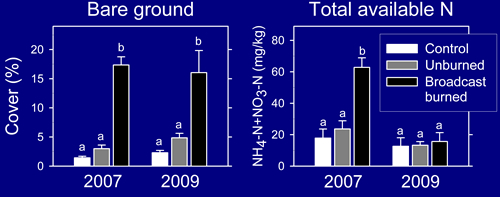 |
| Effects
of fuel-reduction methods on soil properties, one and
three years after treatment. Values are plot means (+1
SE, n = 3). Letters denote significant
differences among means within years. |
|
Local
effects of burn piles. Pile
burning created intense, but localized scarring (white ash and reddened
mineral soil; photos, right), but only the centers of scars showed
signs of severe burning. Initially, the concentration of available
N was more than twice that of broadcast-burned plots and four times
that of unburned plots (figure below: Total available N). By year
3 (2009), however, available N was markedly reduced.
Similarly,
plant recovery within scars was rapid around the edges and dominated
by meadow species (figure below: Plant responses).
| Local
effects of burn piles |
 |
| Effects
of burn piles on soil properties and plant responses,
one and three years after treatment. Values are plot means
(+1 SE, n = 3). Letters denote significant
differences among means within years. |
|
Effects of soil disturbance by gophers on recovery from burning. Tunneling
and mounding by gophers (Thomomys mazama) are disturbances
that are integral to the community structure of these herb-dominated
habitats (see Gopher disturbance). Far less active in the forest, gophers readily
disperse into openings created by tree removal and fire. Evidence
of their disturbance (mounds and castings) increased over time (figures,
below).
Mixing
of sub-surface and surface soils led to rapid healing of burns scars,
dampening the physical and chemical effects of fire in both broadcast-
and pile-burned plots (photos, right; figures, below). Deposition
of mineral soil on the surface may benefit plant establishment.
Thus
tree removal, through its influence on gopher populations, may be
more critical to the restoration of these meadows than any short-term
benefit (or adverse effects) of fire.
| Soil
disturbance by gophers |
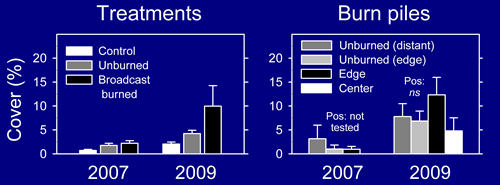 |
| Soil
disturbance by gophers among treatments (left) and in
and adjacent to burn piles (right), one and three years
after treatment. Values are means (+1 SE). For both comparisons,
gopher disturbance increased over time, but did not differ
among treatments or by position (Pos) within burn scars. |
|
 Establishment
of undesirable species Establishment
of undesirable species
Ruderal
or exotic species. Ruderals
were surprisingly sparse in the post-treatment vegetation, despite
their abundance in the seed
bank, and the potential for fire to promote their establishment.
However,
Rumex acetosella (present prior to disturbance), has expanded
in several scattered locations
(photo, right),
and should be monitored in the future.
Conifer
seedlings. We
anticipated greater recruitment of conifers in burned than in unburned
plots, due to a preference for mineral soil as a substrate for germination.
However,
seedlings densities were low (<0.05 seedlings/m2 in
2009) and comparable between treatments, suggesting limited importance
of re-invasion by conifers in the short-term.
However,
where conifers have established (primarily near the edges of experimental
plots), height growth has been substantial (photo, right). Because
propagule pressure remains high and potential germination sites
are plentiful, conifer recruitment should be monitored in the future.
| Undesirable
species |
|
_Plot%202_7.8.jpg) |
| Grand
fir seedlings, year 5 (2011) |
|
|
|
Ground-surface
conditions
following fuel reduction |
| Broadcast
burning |
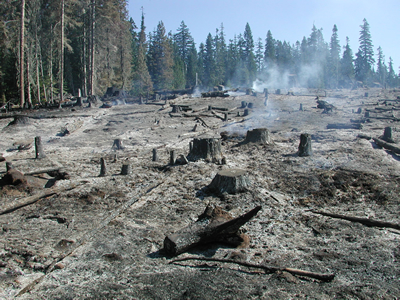 |
| Note
charred litter and absence of unburned ground. |
|
| Pile
burning |
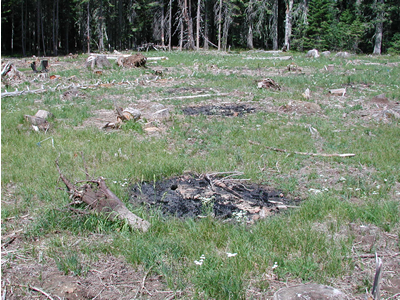 |
| Note
burn-pile scars and predominance of unburned ground. |
|
| Burn-pile
scar |
_5%20Jul%202007.jpg) |
| Note
white ash and reddened mineral soil (center) and
blackened litter (edges). |
|
|

Gophers
mediate
effects of prescribed fire |
| Broadcast
burning |
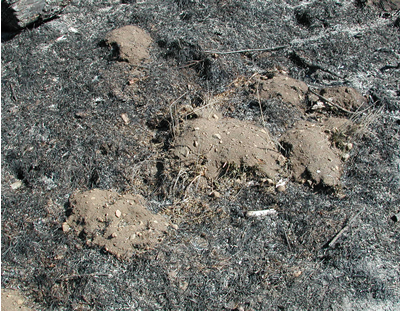 |
| |
| Burn
piles |
_2%20Jul%202007.jpg) |
| |
_7.8.jpg) |
| |
|
 |
![]()
![]()
![]()
![]()




_6%20Jul%202007.jpg)
_Plot%202_7.8.jpg)


_5%20Jul%202007.jpg)

_2%20Jul%202007.jpg)
_7.8.jpg)